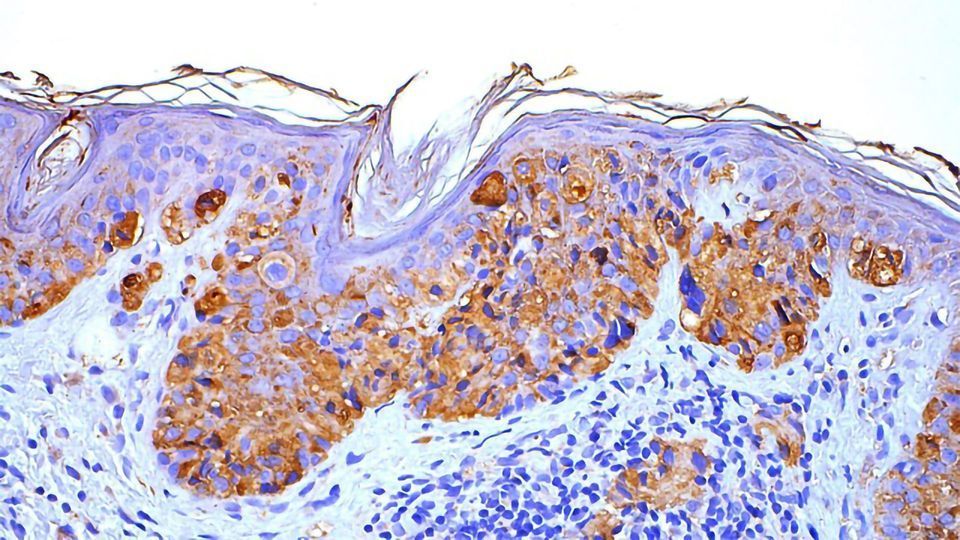Melanoma Variability at the Single-cell Level Can Predict Treatment Response

Complete the form below to unlock access to ALL audio articles.
Patients with advanced melanoma have been able to live longer because of several newly approved targeted treatment options, including BRAF and MEK inhibitors. However, patients will often have different responses to the same treatment due to genetic variability. Melanoma varies from patient to patient, but genetic variability is also prevalent among different cells from a single tumor.
In a new study published in EBioMedicine, researchers revealed that differences at the single-cell level can predict responses to initial BRAF inhibitor therapy, and that leveraging these differences may improve patient outcomes.
Approximately half of all melanoma patients have mutations in the BRAF gene that promote cancer growth. Drugs that target BRAF and the downstream signaling protein MEK have significantly improved patient outcomes, but patients with advanced melanoma are rarely cured with these drugs and most will eventually develop drug resistance and relapse. However, some patients with BRAF-mutated melanoma can be successfully retreated with BRAF or MEK inhibitors. Researchers wanted to determine how differences between cells of a single tumor lead to better responses to BRAF/MEK inhibitors in certain patients.
The research team assessed the variability of melanoma cells and their responses to BRAF inhibitor treatment by analyzing the RNA expression patterns in single cells from melanoma cell lines and patient samples. They discovered that melanoma cells can reside within four different states with distinct patterns of gene expression. Their analysis predicted the following:
State 1: Cells that divided more frequently and were more sensitive to BRAF inhibitors.
State 2: Cells that were less proliferative with a higher level of MAPK signaling.
State 3: Cells enriched for expression of the genes EGFR, c-JUN and Axl and were more resistant to BRAF inhibitors.
State 4: Cells undergoing cell death.
The researchers found that maintaining a population of cells within the drug-sensitive State 1 was critical to maintaining drug sensitivity. Cell lines that lacked a population of cells within State 1 were more resistant to BRAF inhibitor treatment and could not be successfully rechallenged with a BRAF inhibitor.
These observations, along with evolutionary principles, were used to create a mathematical model to show that it is possible to maintain drug-sensitive cell populations in State 1 by using an adaptive dosing schedule. Normally, melanoma patients are treated with a continuous dosing schedule with the intent of killing many cancer cells as quickly as possible. This continuous dosing approach often leads to the development of drug-resistant tumor cell populations. During an adaptive dosing schedule, the decision to hold or initiate drug treatment is based on predicted tumor growth and individual factors.
“Our goal was to achieve initial tumor shrinkage and then to maintain sensitive cells within the tumor, preventing the uncontrolled expansion of the more resistant cellular states,” explained Inna Smalley, Ph.D., a member of Moffitt’s Department of Tumor Biology.
The researchers validated their mathematical model in mouse experiments by showing that adaptive dosing schedules resulted in stronger anti-tumor responses compared to standard continuous dosing schedules. They hope that their studies in cell lines and mouse models will lead to improved treatment approaches for patients.
“Our findings further provide the proof-of-concept that resistance can be delayed through adaptive scheduling of existing FDA-approved drugs, with the advantages of reduced drug exposure and toxicity to the patient,” said Smalley.
The research team will assess the feasibility of this adaptive treatment approach in a phase 1 clinical trial of BRAF-MEK inhibitors in advanced melanoma patients at Moffitt.
Reference
Smalley, I. et al. (2019). Leveraging
transcriptional dynamics to improve BRAF inhibitor responses in melanoma. EBioMedicine.
DOI: https://doi.org/10.1016/j.ebiom.2019.09.023
This article has been republished from the
following materials. Note: material may have been edited for length and
content. For further information, please contact the cited source.

